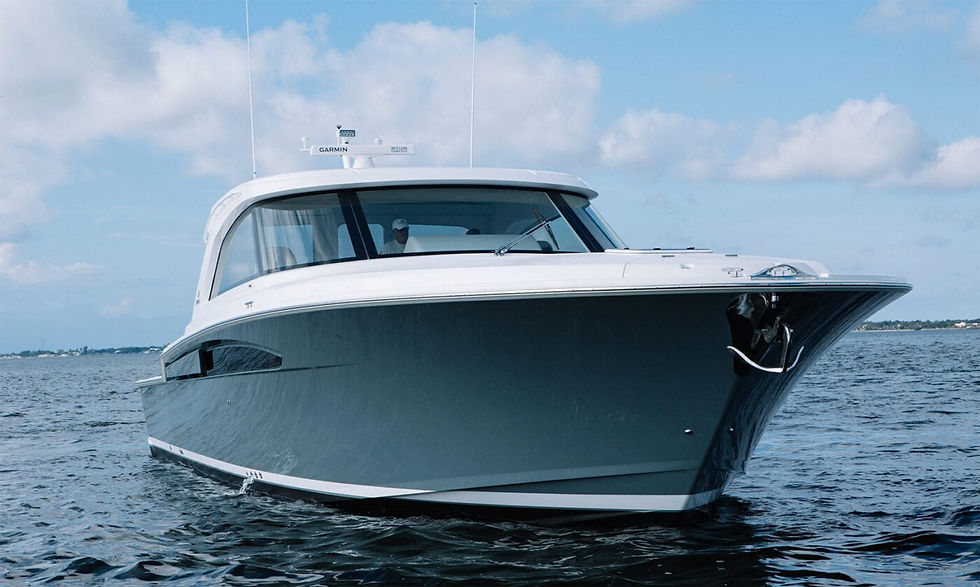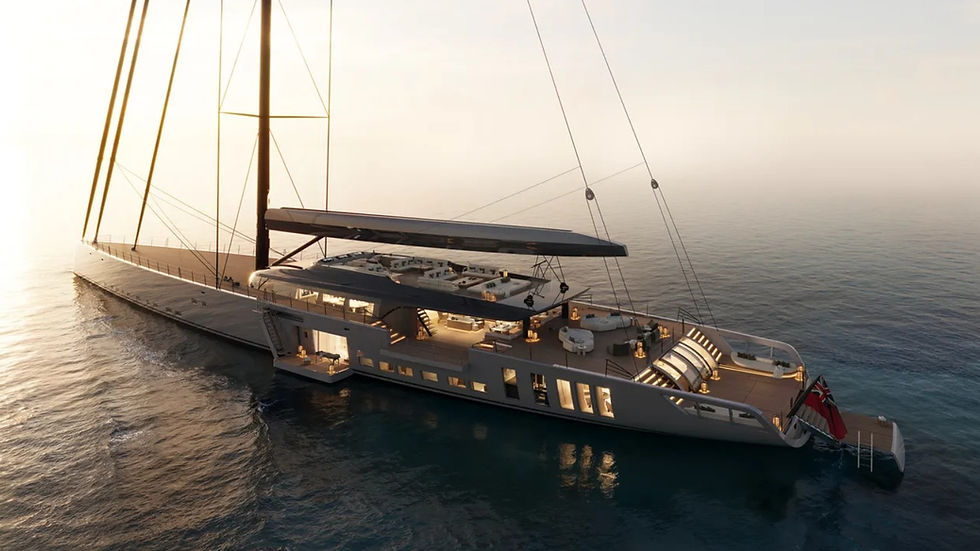The Quiet Innovators in Boating (Part 4)
- Richard Crowder

- Sep 21, 2022
- 7 min read

In Part 4 of The Quiet Innovators, I want to introduce two more individuals who have, somewhat like the quiet icons in Part 1, Part 2, and Part 3 arguably introduced products or services which have revolutionized, to a greater or lesser degree, the pleasure boat industry and who are largely unknown to even some boating aficionados.
Perhaps that’s because these quiet innovators are largely boat designers – those backroom engineers and naval architects who toil by a drafting table or a computer screen with a CAD program and when they are done their designing and production, quietly move on to the next project.
1) David Livingston
I knew David back in the late 70's and early 80's and was always impressed with his quiet confidence and wealth of boating knowledge. He was head of design for Bayliner at the time, and eventually responsible for the Capri design that helped send Bayliner sales into the stratosphere. I would always joke with him about the Capri’s “Sequential Lift Hull” sales moniker. Don’t all modified or deep-vee hulls lift sequentially when coming up onto plane?
It is said that David Livingston has designed more pleasure boats than anyone else in the industry. He built his first boat at age 15 from plans in Popular Mechanics. He then built his first hydroplane, which he raced and water skied behind. It all started in earnest in 1967 when Livingston Boats Incorporated started in Washington state and created the 8-foot Livingston dinghy, a very stable utilitarian catamaran design that eventually grew into a series. It is claimed that perhaps 75,000 of these dinghies were built over its highly respected lifetime.
David and his wife literally fabricated together, building and expanding the Livingston dinghy line until it was purchased by Reinell in the late 70's. David then went to Bayliner in Arlington, Washington at the start of that company’s exponential growth, jockeying with Sea Ray as the world’s largest builder of pleasure boats.
David supervised the design of most of Bayliner’s newer models into the 1980’s, including the Capri and Ciera lines as well as the 32, 37, and the 45 and 47 pilothouse models, which to this day have developed almost a cult following with their reputation for seaworthiness, reliability and quality. Following Brunswick Corporation’s purchase of Bayliner in 1986, Livingston moved into the Presidency of Bayliner for two years from 1988-1989.
David then left Bayliner and designed and started building in his garage a 21-foot runabout with a stepped hull bottom. Along the way, he also did design work for Wellcraft, Reinell, and Larson. At this point, following college, David’s son John had started and built up the US Division of a major marine steering, control, and accessory company, U-Flex. John left U-Flex and joined his dad and the two became partners in boat-building.
At a subsequent trade show, David’s old friend Paul Kuck, head of Orlando, Florida’s Regal Marine became very excited about the boat David and John were building, so much so that they were enticed to move, along with the prototype boat, to Regal’s Florida facility. The result was Regal’s patented FasTrac and OceanTrac hull designs, which were launched to much acclaim in 1996. Together over the next couple of years, the Livingstons designed several Regal models incorporating the FasTrac design. The resulting efficiencies and marketability gained from FasTrac over the past quarter century has helped propel Regal into being one of the premier pleasure boat manufacturers.
After three years at Regal, David and John moved back to the west coast where they decided to set up their own boat-building company. By chance they met the owner of Ranger Fiberglass Boat Company of Kent, Washington who wanted to sell and move to Florida. David along with John and his wife Jennifer bought the 40 year old company in 1998.
In 1999, they created Fluid Motion, LLC in Kent, WA as a holding company. Ranger Tugs became the new name of the brand, which at that time had only the R21 Tug along with a sailboat. The demand for the tug was much more than they expected and by 2006 they had designed, built, and introduced the R25 Tug to instant success.
The line has since expanded to nine models from 23 to 43 feet with diesel inboard or gasoline outboard power. The 23, 25, and 27 are all legally trailerable without permits, a huge benefit for certain ownership demographics. In 2011, they introduced Cutwater Boats targeted as a feature-packed but affordable family boat. Now Cutwater offers 10 models from 24 to 32 feet.
But David and John didn’t stop there. In 2022, Fluid Motion, LLC introduced its new “luxury adventure brand” Solara, designed to be “fun, fast, and versatile.” Solara models cater to cruising, fishing, and watersports with more built-in standard and upscale features. Solara currently offers three 25-foot models and one 31--footer.
Before partnering with his son John, David Livingston has arguably had more design influence on more pleasure boat models than any other single person. During that time and since working with his son John, the pair have been responsible for literally dozens of pleasure boating patents, all aimed at making our time on the water more pleasurable and safer. In 2015, David became only the sixth person to receive the Northwest Marine Trade Association prestigious “Legend” award.
2) Michael Peters

Like so many other designers, you perhaps have not heard this name but Michael Peters is among the most renowned boat and yacht designers in the world. Today, through his company, Michael Peters Yacht Design (MPYD) of Sarasota, Florida he has upward of 500 boat designs to his credit with some of the most recognizable manufacturers in the world.
Born and raised in California, his boating interest started in his teens when he was put in charge of keeping the small fleet of skiffs in usable shape at his family’s camp, Campus by the Sea, on Catalina Island. In 1967, at the age of 14, he designed his first boat, an 8-foot sailing dinghy. He became handy with fiberglass and woodwork and at age 16 he figured out how to draw in reverse from a boat he liked to create plans from which he could build a duplicate boat.
He then designed and built a 14-foot workboat for a commercial dive operation. He then spent time studying engineering and architecture at the University of Southern California, but dropped out after three years to concentrate on building a prototype of a stepped hull design he wanted to patent. The patent design was called “Internally Vented Continuous Chine Stepped Hull.”
Boatbuilders at that time were not interested in stepped hulls but Halter Marine of New Orleans, which had recently purchased Cigarette Boats, purchased some rights to the pending patent. Don Aronow test drove the 19-foot prototype called Maelstrom powered with a four-cylinder Volvo sterndrive but afterwards told Halter to forget about the design.
Peters worked three years at Halter Marine as a Naval Architect working on a variety of pleasure and commercial designs, custom yachts, patrol boats, and even surface-effects boats with Bell Aerospace. He received his stepped hull patent in 1980, and in 1981 created Maelstrom Marine Design, Inc. in Sarasota, Florida. Within three years, his first offshore racing Maelstrom catamaran named Innovation set a UIM Class II speed record of 131 mph. Michael Peters’ name was beginning to be known.

His Apache-built 41-foot Maelstrom catamaran won his first US1 National Offshore Racing Championship in 1986. A couple of years later, I was introduced to Michael as the designer of a similar 41-Apache-built Maelstrom catamaran fabricated in Oakville, Ontario by CS Yachts for Canadian offshore racing legend Lorne Leibel. It was his new Canada Homes entry for the US1 offshore racing championship.
Peters enjoyed a sweep of 13 consecutive world championships from 2000 through 2012, and in 2016 MPYD designs claimed its 20th World Offshore racing championship. Along the way, Peters received the 1990 Kiekhaefer “Innovation in Offshore Racing” award. In 1991, his offshore-winning Iceberg cat built by Tencara of Italy for Ferretti was the first to be built using advanced carbon/epoxy composite technology.
In 2005, his 43-foot Callan Marine designed cat became the first offshore boat in history to top the 200-mph barrier at 209 mph. In 2012, he was awarded a patent for his “Stepped-V Ventilated Tunnel” design.
While offshore racing perhaps created the name for Michael Peters, outside of the racing scene he perhaps created an even bigger reputation. In 1993, he helped design the 125-foot Difinitive concept for Tencara of Italy ushering in new concepts, trends, technologies, and designs for superyachts.
He won back-to-back Showboats Awards in 1995 and 1996 for the 117-foot Lady Tiffany and 71-foot Plumduff, respectively. His stunningly gorgeous and award-winning 33-foot Van Dam built runabout Alpha Z came in 1996. In 2005, MPYD won the International Superyacht Design Award for the 84-foot Jariya while his multiple designs of 76 to 87-foot express and flybridge cruisers in Cheoy Lee’s Alpha series won the 2012 World Yachts Award.
Michael Peters Yacht Design has worked with some of the biggest boat brands in the industry. He was once asked by Chris-Craft to rebrand its model line, and he is responsible for the stylish retro look that you see in the lineup today. He has worked with Bertram and Hinckley, as well as Viking’s Valhalla line of center consoles from 33 to 55-feet.

Most recently is his 2022 pleasure yacht, the Outback 50. MPYD has also designed a series of forward-looking stepped-hull 61-footers for the US Navy SEALs. Michael Peters’ designs have ranged from 20-160 feet, with the bulk of them being in the 40 to 60-foot range.
Looking to the future, MPYD is focusing on electric propulsion and hydrofoils. It has already worked with Hinkley’s Dasher electric project and with Zodiac on an electric tender. Michael Peters says that in his mind, traditional boating is no longer in vogue and that, in terms of cruisers, people want a “home on the water” with all its conveniences and none of the compromises of a boat. Rightly or wrongly, I couldn’t agree more.
Don't miss:
























All I can say is I'm a big fan of Micheal Peters. In addition to his design work I enjoyed his columns in Power and Motor Yachts. He is a good writer.